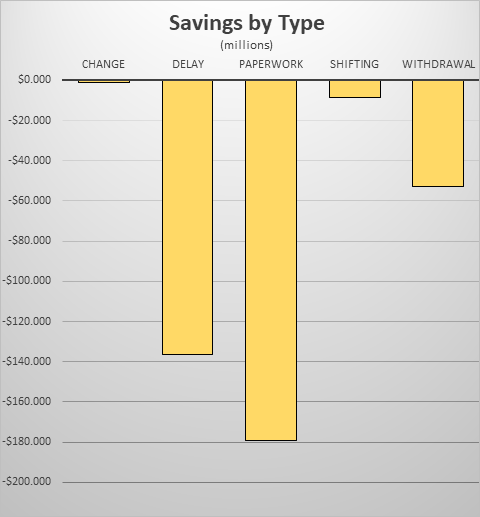Insight
December 1, 2017
Deregulation Under Trump: Where are the Savings Coming From?
Over its first ten months, the Trump Administration has made a significant effort to change the culture of regulatory agencies. Executive Order 13,771 directed agencies to produce net savings with their regulations instead of focusing primarily on new areas to regulate or tightening existing standards.
While the executive agencies have made progress in reducing regulatory burdens, it is important to get a sense of where the cost savings have come from.
American Action Forum (AAF) research shows that most of the reduced costs come from paperwork streamlining and delays in implementation. In contrast, just a fraction of one percent of the realized savings come from substantive regulatory changes.
Methodology
AAF analyzed the 16 rules classified as final Executive Order 13,771 deregulatory actions with net estimated cost savings published in the Federal Register from January 23 until November 27, 2017. This analysis excludes rules nullified by the Congressional Review Act. Savings estimates were categorized by type based on a description of those savings offered in the Federal Register notice for each rule.
AAF identified five categories of savings:
- Shifting of responsibilities (away from public sector to contractors)
- Delays (such as extending compliance deadlines)
- Paperwork (including information collection requests, applications, and reporting)
- Regulatory changes (modifications in how the regulation functions)
- Withdrawal of rules
The rules are listed below:
| Regulation | Annualized Cost Savings (millions) | Primary Category |
| Migratory Bird Subsistence Harvest in Alaska; Use of Inedible Bird Parts | -$0.362 | Change |
| Student Assistance General Provisions, Federal Perkins Loan Program | -$9.247 | Delay |
| Cranes and Derricks in Construction: Operator Certification Extension | -$5.200 | Delay |
| Improve Tracking of Workplace Injuries and Illnesses: Delay of Compliance Date | -$0.021 | Delay |
| Delay: Nutrition Labeling of Standard Menu Items | -$8.000 | Delay |
| Fiduciary Delay | -$78.000 | Delay |
| Postponement of Certain Compliance Dates for the Effluent Limitations Guidelines | -$36.000 | Delay |
| Medicare and Medicaid Programs; CY 2018 Home Health Prospective Payment System Rate Update | -$145.986 | Paperwork |
| Medicare Program: Hospital Outpatient Prospective Payment and Ambulatory Surgical Center Payment | -$14.000 | Paperwork |
| Medicare Program; CY 2018 Updates to the Quality Payment Program | -$11.700 | Paperwork |
| Hospital Inpatient Prospective Payment Systems for Acute Care Hospitals | -$3.854 | Paperwork |
| Inpatient Rehabilitation Facility Prospective Payment System | -$2.564 | Paperwork |
| Control Order for Introduced Migratory Bird Species in Hawaii | -$0.006 | Paperwork |
| Fisher Houses and Other Temporary Lodging | -$1.990 | Paperwork |
| Error Rate Measurement Programs in Response to the Affordable Care Act | -$8.380 | Shifting |
| Scope of Sections 202(a) and (b) of the Packers and Stockyards Act | -$52.860 | Withdrawal |
Of the 16 rules, only one clearly identified more than one cost-savings category: the Hospital Inpatient Prospective Payment Systems for Acute Care Hospitals rule, which accrued its savings primarily from paperwork reductions, with some from regulatory changes.
Findings
The annualized savings from these rules comes to $378 million. Nearly half of those savings are derived from paperwork reductions ($179 million, or 47 percent). Another significant portion comes from delays ($136 million or 36 percent). Of the remaining 17 percent, just .29 percent (or $1.1 million) comes from regulatory changes. The chart below breaks down the cost savings for each category.
By the count of regulations, paperwork reduction and delays make up a similar proportion of deregulatory activity. Of the 16 rules, seven derived all or most of their savings from reductions in paperwork. Six rules earned savings from delays. There was one rule apiece from each of the remaining categories – regulatory changes, shifting responsibility, and withdrawal.
These findings show that regulators are more easily identifying assessable cost savings in paperwork requirement reductions and compliance delays than in substantive changes to regulations or simple withdrawals. The likely reason is that these actions are less controversial and require less justification than major changes. They also require less time. Changes and withdrawals generally need to be proposed and available for public comment for longer periods of time than other types of changes.
Implications for 2018
Next year holds greater potential for more savings derived from substantive changes and less from simple delays. Many of the delays were to rules finalized under the Obama Administration. The Trump Administration could justify these delays politically by arguing that holding them would provide adequate time to assess impact and ensure regulated entities have a better chance to comply. The further we get from Obama-era rules, however, the fewer compliance deadlines there will be to delay, as more and more will have come into full effect.
In 2018 we should expect more notable deregulatory actions to be finalized. Some of the rules that the Administration will likely rescind or substantially revise are the Environmental Protection Agency’s Clean Power Plan and Waters of the United States rules (both of which the agency proposed to rescind this year), and the Department of Labor’s overtime rule. There are potentially billions in savings from these rules alone. While the savings from additional delays may be drying up soon, expect more substantive regulatory actions – and savings – in the year ahead.











